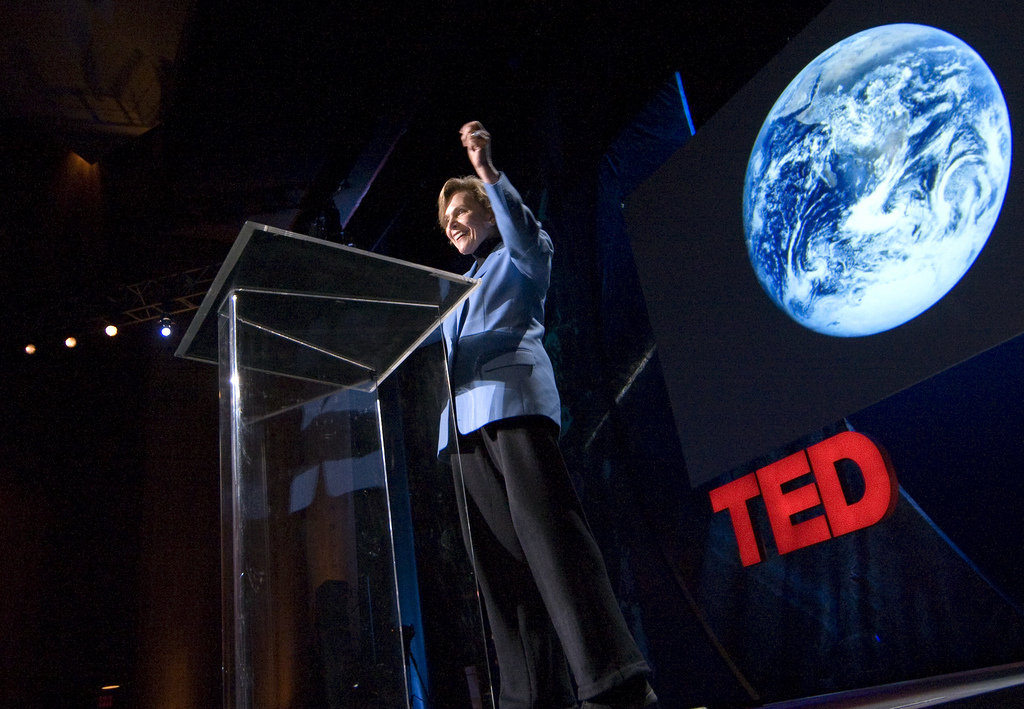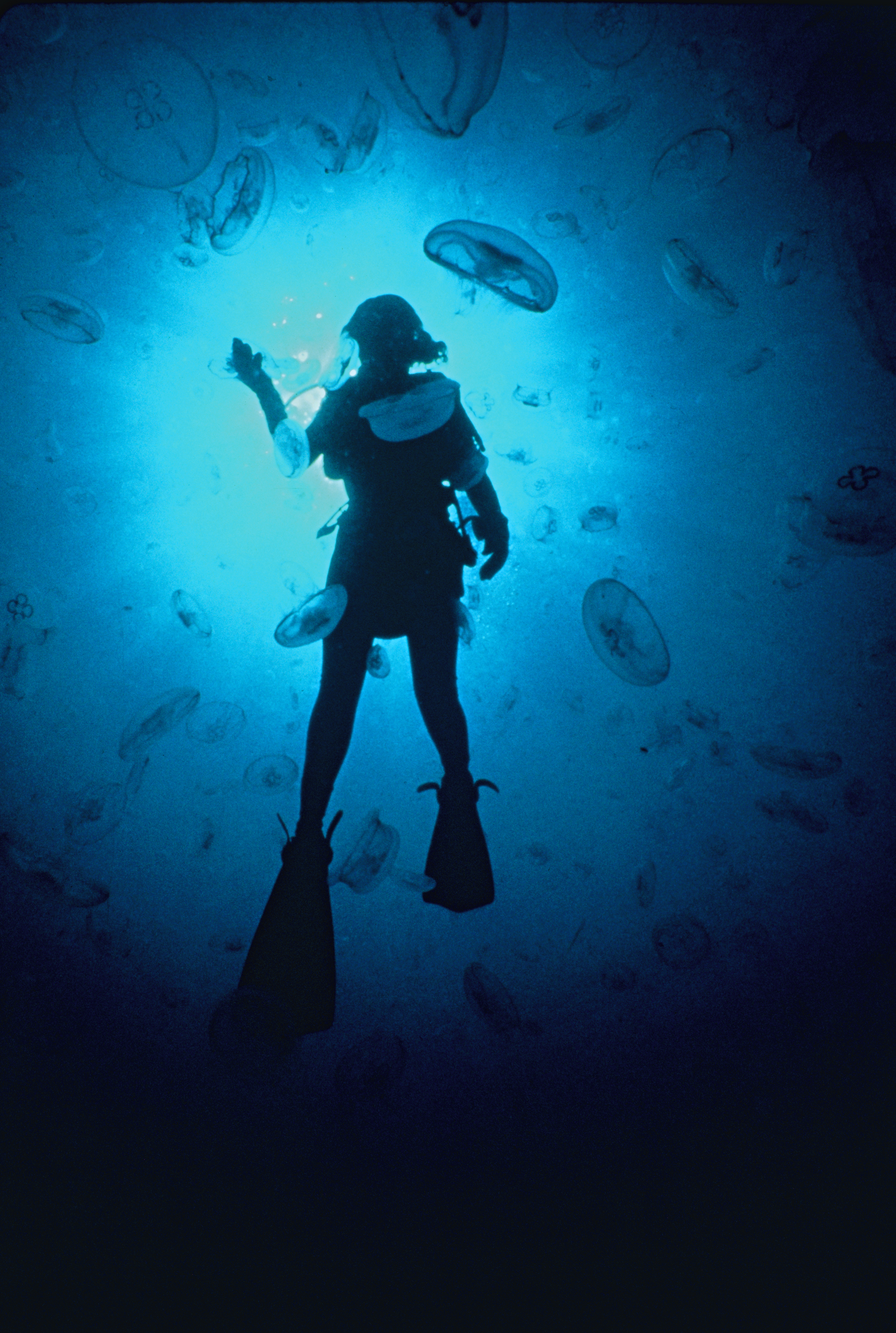Sylvia Earle is a fearless 78-year-old woman. In the new documentary Mission Blue, we watch her dive with sharks in the deep blue sea and fearlessly dodge fishing nets as she swims through the middle of a major fishing operation. The film offers a bold new view of the famed oceanographer whose relentless pursuit of saving the ocean takes her from the mythical expanse of Australia’s Great Barrier Reef to the swirling schools of the Chesapeake Bay menhaden fishery to the bustling fish markets of Tokyo.
Mission Blue is now available on Netflix. Watch it here »
Directed by Fisher Stevens (The Cove) and Bob Nixon (Gorillas in the Mist), Mission Blue serves up visually stunning underwater footage. But beyond that, it weaves an inspiring storyline that focuses on Earle herself. Mission Blue could have easily been a documentary about the devastation of the ocean, but Stevens and Nixon felt wary of making a film full of scientific data and talking heads for an audience not already enthusiastic about ocean conservation — and likely feeling compassion fatigue. So Stevens and Nixon tossed out their first script, which focused on Earle’s concept of “hope spots,” underwater areas so critical to the health of the ocean that they need to be protected by law. Instead, the filmmakers turned their focus on the legendary eco-activist herself.
With icon status as a National Geographic Explorer-in-Residence, Earle was a female biologist in “a time of bearded scientists,” one whose ongoing efforts to save the ocean have been recognized by presidents Bill Clinton, George W. Bush and Barack Obama. Meanwhile, her sweeping romantic history offers human interest. “That’s what makes the movie work, at least for me; you get emotionally attached to Sylvia and you see the ocean through her eyes,” says Stevens, who met Earle on a TED-led expedition to the Galapagos Islands after she was awarded the TED Prize in 2009. “I spent one week with her and I was hooked. After the Galapagos trip, I really didn’t want to leave Sylvia’s world, so I didn’t.”
The film opens with Earle and a team of scientists surveying whale sharks off the coast of Louisiana, about 60 miles from the site of the 2010 Gulf of Mexico oil spill, the worst in US history. In her scuba gear, which is like a second skin for her, Earle plunges into the water and swims alongside these majestic creatures, which can be up to 40 feet in length. She makes no secret of her love of sharks and dispels the widely accepted belief that we, as human beings, are on their lunch menu. “They’ve been living here for millions of years. We’re newcomers in their backyard,” she says. “I love being a part of their world. They’re completely innocent of anything humans do.” By innocent she means, for example, that they haven’t had a role in building the more than 33,000 oil drill sites in the Gulf, even though their habitats have been adversely affected by them.
With no problem being in the water for 12 hours at a time, the ocean is as much as a comfort zone to Earle as land is for the rest of us, and it’s heartbreaking for her to have witnessed its decline. “Sixty years ago, when I began exploring the ocean, no one imagined that we could do anything to harm it,” she says. “But now we’re facing paradise lost.”
As Earle sees the narrative of the ocean, human beings are in some ways the bad guys. The film takes a hard look at how our global appetite for seafood has brought many species to the edge of extinction. A heart-stopping moment comes toward the end of the film, when Earle returns to a location 100 miles into the Coral Sea, which she visited decades before and remembers for its vibrant array of ocean wildlife. Only on this dive, there are barely any fish; only coral reef ruins. It looks like a graveyard.
Mission Blue escorts us through Earle’s youth – which opened up when her family moved from New Jersey to Florida when she was 12 years old. Antique footage of Earle swimming in the Gulf as a young woman and as an up-and-coming scientist diving on early expeditions gives a nostalgic twist, and reaffirms the sense that Earle is doing the work she was born to do. “As a kid, I had complete freedom. To spend all day out [in nature] just fooling around on my own,” she says. She became “entranced by the idea of submarines” after reading the book Half Mile Down by marine biologist William Beebe, who she regarded “as a soul mate.” She was also inspired by Jacques Cousteau. “His silent world made me want to see what he saw,” she says. “To meet fish swimming in something other than butter and lemon slices on a plate.”

Sylvia Earle shares her TED Prize wish in 2009. Photo: James Duncan Davidson
Throughout the film, Earle is both charming and a force to be reckoned with. On the road 300 days of the year, she spends her time campaigning, meeting with world leaders, guest lecturing and, of course, diving—she can’t help but make the rest of us feel like we’re slacking off. Self-effacing at her core, her giggly charisma is contagious, yet she can also be serious when she needs to be. In the film, there’s a snippet of an interview with Stephen Colbert, who teases her that the ocean “is deep and dark and full of sharks who want to eat us,” so why should he care about it? Earle’s response elicits a chilling reaction: “Think of the world without an ocean. You’ve got a planet a lot like Mars.”
Most admirable, perhaps, is Earle’s intolerance for bureaucratic faffing on environmental change that doesn’t lead to concrete action, and that can even conceal the severity of ocean degradation. She is not afraid to ruffle feathers if it means saving more gills. Her brief stint as the Chief Scientist at the National Oceanic and Atmospheric Administration (NOAA) proved too stifling for her—we see her as she resigns with dignity, preferring to venture out on her own, with the freedom to speak her mind rather than maintain silence on matters close to her heart.
“The thing that’s impressive to me about Sylvia is that she is not afraid to point fingers, and say ‘you know what you’re doing and it’s wrong,’” says Jeremy Jackson of the Smithsonian Institution, one ocean activist interviewed in the film. Director James Cameron (whose journey 36,000 feet down is chronicled in his new documentary Deepsea Challenge 3D) meanwhile describes Earle as “the Joan of Arc of the ocean.”
Getting media coverage has never been difficult for Earle, but the coverage was somewhat sexist in the earlier part of her career. Take, for example, the headline “Sylvia Sails Away with 70 Men (But She Expects No Problems)” after her first scientific expedition to the Indian Ocean. As much as the media played up the fact that she was a woman in a man’s world, when it came to her love life, Earle says: “I wasn’t interested in anybody who wasn’t interested in what I was interested in. I was attracted to the nerdy types who loved talking about stars and space, or about diving.” This probably explains how she met her second husband at what she calls “a scientific meeting about fish.” A true feminist, Earle juggled being a mother, a wife and a scientist, among other things, but no matter the obstacles she faced soaring through the proverbial glass ceiling, Earle never saw herself as a victim. “That’s life!” she says with her signature infectious optimism.
In the film, Earle takes on criticism that she is a radical. Most people, she reminds us, haven’t had the opportunity to spend thousands of hours underwater like she has, and to see the kind of destruction to the ocean that she’s seen over the course of her lifetime. With fifty percent less coral in the ocean now than there was in 1950, Earle says simply, “the ocean is dying,” with a deep sadness. While only 5% of the ocean has been seen, let alone mapped and explored, “if we continue business as usual, we’re in real trouble,” she says.
Yet Mission Blue is not all doom and gloom, as Earle is hopeful: “We still have a chance to fix things,” she says, noting that it’s a matter of getting everyone committed to the cause of ocean conservation. Viewers come away with a bigger, more pronounced understanding of the catastrophic impact of human behavior on the world’s oceans—and what we can do to start changing it.
In the end, what are the takeaways from Mission Blue? That following your passion makes for an exciting life; that sometimes you have to go against the grain to make a difference. And finally, that we’re all interconnected on this planet, which means that we all need to be mindful of the consequences of our choices.

Sylvia Earle amidst jellyfish. Photo: Courtesy of Mission Blue
This piece originally ran on the TED Prize Blog. Head there to read more about our annual award to a dreamer with a wish for the world »
Comments (6)